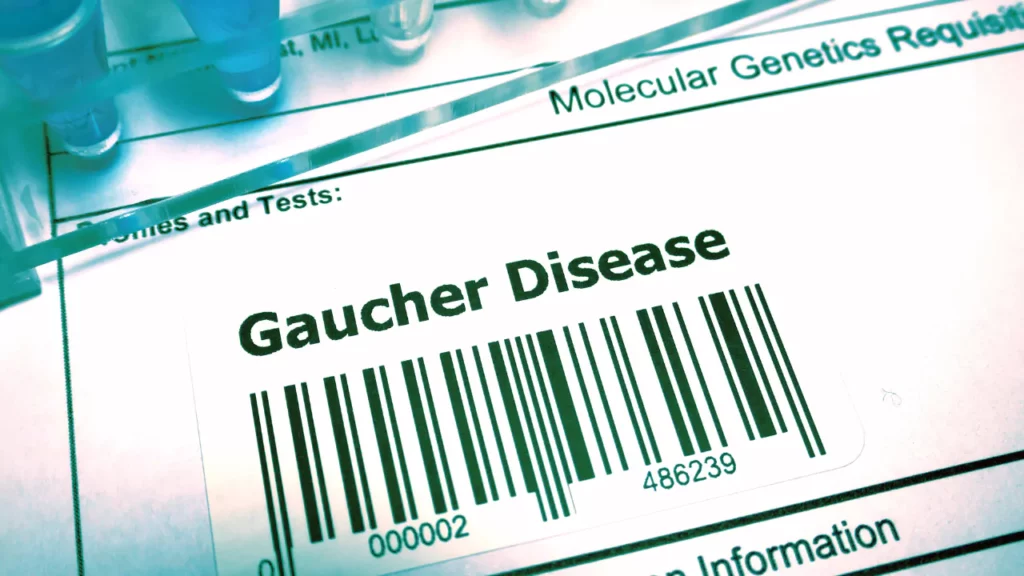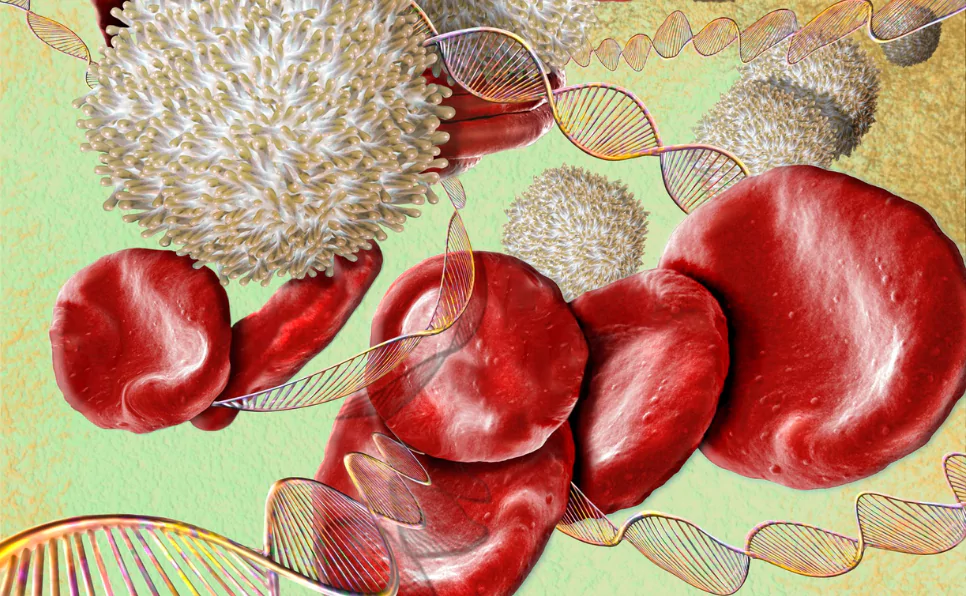Gaucher disease is a rare inherited genetic disorder. The onset and severity of symptoms vary across the three types of Gaucher disease (Types 1, 2, and 3).
Currently, treatments are available only for Type 1 and for some non-neurological symptoms of Type 3 Gaucher disease.
Key Takeaways
- Type: Lysosomal storage disorder
- Causal Gene: Mutation in the GBA gene resulting in the deficiency of glucocerebrosidase enzyme.
- Inheritance Pattern: Autosomal Recessive
- Main Symptoms of Type 1: Belly pain, joint pain, easy bruising, prone to fractures, fatigue, respiratory problems
- Main Symptoms of Type 2 & 3: Seizures, jerking movement of hands, poor coordination, belly pain, cognitive impairment
- Diagnosis: BGL test (blood test) and Genetic testing
- Treatment: Enzyme Replacement Therapy and Substrate Reduction Therapy
Understanding Gaucher Disease
What is Gaucher Disease?
Gaucher disease is an inherited lysosomal storage disorder. The disease is caused by the deficiency of the enzyme glucocerebrosidase.
This enzyme is essential for breaking down specific fats. Without it, these fats get loaded inside a certain type of cells called Gaucher cells.
Fat-loaded Gaucher cells accumulate in various body parts, mainly the bone marrow, spleen, and liver, leading to organ damage and the symptoms of the disease.
There are three types of Gaucher disease:
Type 1 Gaucher disease
- Symptoms include enlargement of the liver and spleen, a low number of red blood cells, and platelets, bone abnormalities, and joint conditions.
- Symptoms typically appear anytime from childhood to adulthood.
- Condition ranges from mild to severe.
- Usually, the brain and spinal cord are not affected.
- Type 1 Gaucher disease is treatable.
Type 2 Gaucher disease
- It occurs rarely.
- Symptoms are like Type 1. But also include seizures and brain damage.
- Symptoms typically appear within the first six months of the child.
- Affects the brain and spinal cord along with other organs.
- Type 2 Gaucher disease is not treatable.
- Life expectancy is significantly reduced, often to 2 to 3 years.
Type 3 Gaucher disease
- Like Type 2, Type 3 also affects the brain and spinal cord.
- Symptoms are like Type 2. However, the progression is slower.
- Symptoms typically appear within the first decade of the child’s life.
- Life expectancy is about 20-30 years.
How Prevalent is Gaucher Disease?
Gaucher disease affects up to 1 in 40,000 births in the general population.
The disease is more common among Eastern European Jews of Ashkenazi descent. Within this population, the disease affects approximately 1 in 450 children.
Symptoms of Gaucher Disease
The symptoms of Gaucher disease depend on the type (Type 1, 2, or 3) and the severity varies from person to person.
Type 1 Gaucher disease Symptoms
People with Type 1 Gaucher disease have the following blood, organ, and bone symptoms.
Blood and Organ Symptoms
Enlarged Spleen and Liver. The deposition of Gaucher cells in the spleen and liver enlarges these organs causing a swollen and painful belly.
Lungs. Accumulation of fatty chemicals in the lungs can cause respiratory problems.
Low platelet count. An enlarged spleen due to Gaucher disease destroys blood cells quickly, including platelets. Low platelet counts can cause bleeding issues like nose bleed, gum bleed, and easy bruising.
Anemia. Gaucher cells in bone marrow decrease the production of blood cells, and the spleen destroys whatever blood cells are formed. This causes anemia (low levels of healthy red blood cells) that leads to fatigue.
Bone Symptoms
Bone pain. People affected with Gaucher disease experience severe bone pain resulting from reduced blood flow to the bones.
Bone infarction or avascular necrosis. Parts of the bones do not receive enough oxygen causing bones to deteriorate and die. This often leads to hip and shoulder problems, arthritis, and spontaneous fractures.
Osteopenia and osteoporosis. People affected with Gaucher disease have weak bones due to loss of calcium and mineral content. This causes spontaneous fractures.
Neurological signs and symptoms of Gaucher disease are present only in people affected with Type 2 and Type 3.
Type 2 Gaucher Disease Symptoms
The symptoms become apparent within the first 3 to 6 months. There is an early onset of brain damage that is severe and worsens rapidly. Other symptoms include:
- Poor development
- Seizure
- Jerking movement
- Difficulty in sucking and swallowing
- Enlarged spleen and liver
Type 3 Gaucher Disease Symptoms
Type 3 symptoms have a later and more gradual onset than Type 2. The symptoms of Type 3 Gaucher disease include:
- Seizures
- Respiratory problems
- Cognitive impairment
- Poor coordination
- Eye movement disorders
- Blood disorders
- Enlarged liver and spleen
Genetics of Gaucher Disease
What is the Genetic cause of Gaucher Disease?
Gaucher disease results from a mutation in the GBA gene responsible for making the enzyme glucocerebrosidase.
like we discussed earlier, this enzyme is crucial for breaking down certain fats. Enzyme deficiency because of the gene mutation leads to the accumulation of these fats in areas like the bone marrow, spleen, and liver, causing organ damage and disease symptoms.
How is Gaucher Disease Inherited?
Gaucher disease is inherited in an autosomal recessive pattern.
Usually, we have two copies of a particular gene mutation that we inherit from our parents (one copy from each parent). So, the person must receive the mutated gene copies from both parents to have the disease.
Diagnosis and Testing of Gaucher Disease
How to Diagnose Gaucher Disease?
Diagnosing Gaucher disease involves a primary blood test known as the beta-glucosidase leukocyte (BGL) test, which measures enzyme activity.
This test is crucial for identifying Gaucher disease, as affected individuals exhibit reduced enzyme activity.
For those with a family history of Gaucher disease, genetic testing is recommended.
Individuals without symptoms can still be carriers, meaning they have a mutation in one copy of the gene. Genetic testing, using blood or saliva samples, can identify mutations in the GBA gene that cause the disease.
Understanding your carrier status is valuable for family planning.
Treatment, Cure, and Prevention of Gaucher Disease
What is the treatment for Gaucher Disease?
Type 1 Gaucher disease is treatable because it does not involve neurological symptoms since the brain is not affected. The non-neurological symptoms associated with Type 3 are also treatable.
However, there is no treatment for Type 2 due to quick and irreversible damage to the brain in the early years of the child’s development.
The treatments include increasing the enzyme levels (Enzyme Replacement Therapy) or decreasing the fatty chemicals that build up in the body (Substrate Reduction Therapy).
1. Enzyme Replacement Therapy (ERT)
ERT involves the administration of enzyme infusion directly into the bloodstream through a vein in the arm. The enzyme prevents the deposition of fatty chemicals into different body parts by breaking them down.
ERT is done every two weeks either at infusion centres or at home.
2. Substrate Reduction Therapy (SRT)
SRT involves taking medication orally. The medication decreases the levels of fatty chemicals so they do not build up in body parts.
Ongoing research in the field of Gaucher disease aims at developing new therapies via genetic engineering and stem cell technology.
Can Gaucher Disease be Cured?
No, there is no cure for Gaucher disease. However, with Enzyme Replacement Therapy and Substrate Reduction Therapy Type 1 Gaucher disease and non-neurological symptoms of Type 2 can be treated.
How to Prevent Gaucher Disease?
Preventing Gaucher disease is not possible if a mutation exists in the GBA gene. However, early diagnosis and treatment for those at risk can decrease the damage to bones and other organs associated with Type 1 Gaucher disease.
For families with a history of Gaucher disease, consulting a genetic counselor is advisable. This can help in reducing the chances of passing the mutated gene to the next generation.
Further Reading
- Use of Ambroxol as Therapy for Gaucher Disease (2023) – JAMA Network Open
- Update of treatment for Gaucher disease (2022) – European Journal of Pharmacology
- Overall assessment of patients with type 1 Gaucher disease: a single-centre’s experience (2023) – Journal of Rare Diseases
- Global Epidemiology of Gaucher Disease: an Updated Systematic Review and Meta-analysis (2023) – Journal of Pediatric Hematology/Oncology
- Global Incidence and Prevalence of Gaucher Disease: A Targeted Literature Review (2023) – Journal of Clinical Medicine

Dr. Sumeet is a seasoned geneticist turned wellness educator and successful financial blogger. GenesWellness.com, leverages his rich academic background and passion for sharing knowledge online to demystify the role of genetics in wellness. His work is globally published and he is quoted on top health platforms like Medical News Today, Healthline, MDLinx, Verywell Mind, NCOA, and more. Using his unique mix of genetics expertise and digital fluency, Dr. Sumeet inspires readers toward healthier, more informed lifestyles.





